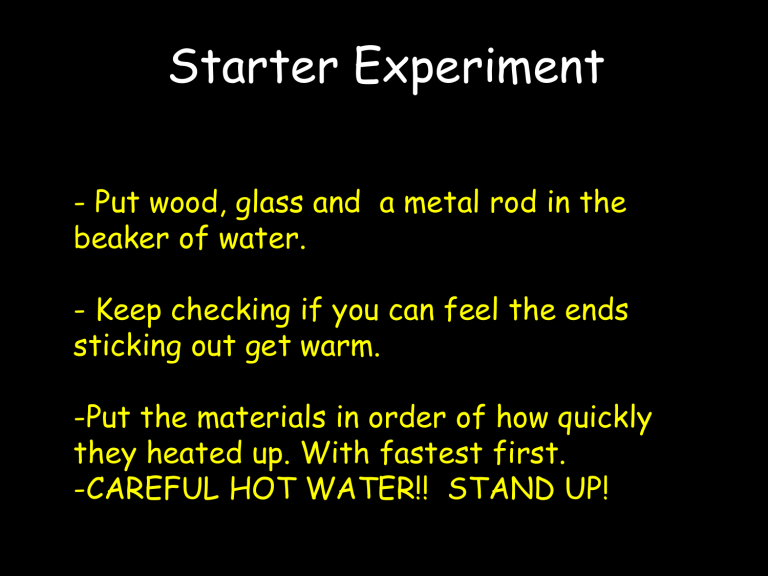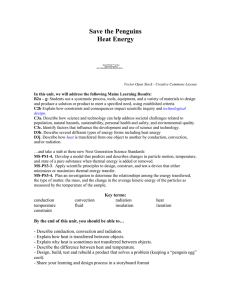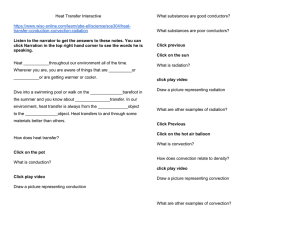
Starter Experiment - Put wood, glass and a metal rod in the beaker of water. - Keep checking if you can feel the ends sticking out get warm. -Put the materials in order of how quickly they heated up. With fastest first. -CAREFUL HOT WATER!! STAND UP! Heat transfer Lo: Describe how energy is transferred by particles in conduction and convection. Conduction CONDUCTION is when heat moves through a solid. Metals are better conductors of heat than plastic or wood. These parts are made of plastic or wood: These parts are made of metal: 16/05/2019 9.2 Conductors and insulators Conduction of heat Conduction is the way in which heat energy is transferred in solids. Metals are the best conductors of heat. 9.2 Conductors and insulators Good conductors A saucepan conducts heat from a heat source through its base to heat the food inside. Copper is a very good conductor; expensive pans often have a copper base. 9.2 Conductors and insulators More good conductors The skewer through a kebab conducts heat to its centre, cooking it more quickly. The soleplate of an iron conducts heat through it to reach cloth being ironed. 9.2 Conductors and insulators Insulators Insulators do not conduct heat Examples of insulators: - paper - wood - air - plastic 9.2 Conductors and insulators Using insulators The lagging on hot water pipes is an insulator. It stops the heat energy getting out which would lead to the water cooling down. 9.2 Conductors and insulators Paper is an insulator Fish and chips are sometimes wrapped in several sheets of paper to keep them hot. Conduction In this experiment we saw that liquid water is a poor conductor of heat. The ice cube did not melt even though the water above it was boiling. Q. So why does all the water in a pan get hot? Air is also a poor conductor of heat. This is how many types of house insulation and clothing keep us warm. 16/05/2019 Copy and fill in the gaps. Energy always travels from hot things to cold things. One way that energy can be transferred is by conduction. Conduction is the transfer of energy in solids. Heat travels from one particle to the particle next to it. In the experiment the heat energy is transferred along the rods by conduction. Cold, energy, molecule, transferred, heat, conduction, hot, particle Copy and fill in the gaps. Energy always travels from hot things to cold things. One way that energy can be transferred is by conduction. Conduction is the transfer of energy in solids. Heat is transferred from one particle to the particle next to it. In the experiment the heat energy is transferred along the rods by conduction. Cold, energy, molecule, transferred, heat, conduction, hot, particle 9.3 Convection Convection When an area of air or water heats up it moves upwards. This is convection. Convection is the way in which heat energy is transferred in liquids and gases. Why does it rise? Convection happens because liquids such as water expand when they get hot. The particles in the water get further apart. heat This means the volume of the water increases. Why does it rise? Although the volume of the water increases, its mass stays the same. This means its density is less than cold water Convection Things which are less dense than water bob up and float on water, like leaves on a pond. The same thing happens in the air – a litre of helium has less mass than a litre of air and so helium balloons float up through the air The same happens to warm water or air. It rises through the colder water or air around it. Convection currents When water is heated …it expands …becomes less dense …and rises Cooler denser water moves in …and is heated in turn …and rises As the warm water rises …it cools …becomes denser …and falls again Using convection The glider uses convection currents, called thermals, to stay in the air. Birds, like this soaring eagle, use convection currents to rise and fall with very little effort. 9.3 Using convection Heating a room Can you explain how the whole room is heated by convection? 9.3 Using convection Hot water tank in a house Where is the water hottest? Which pipe, X or Y, brings cold water into the tank? Which pipe, X or Y, takes hot water out of the tank? 9.3 Using convection Kettles and fridges How does convection heat all the water in the kettle? How does convection cool the whole of the fridge? Convection Convection is all about when a gas or liquid (“fluid”) moves and carries heat with it. When the fluid is heated it ____________. This means that it will become less __________ than the colder fluid around it. Because of this the warmer fluid will try to “_______” over the colder fluid, and this is why warm air rises. This is called a convection ___________. This is how heat reaches us from the ___________ in this room. Words to use: expands, radiators, dense, heated, current, float 16/05/2019

